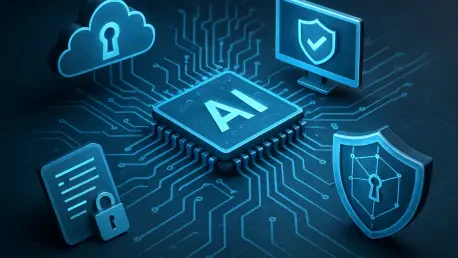Setting the Stage for AI in Cybersecurity
The digital landscape is under siege, with cyberattacks escalating in both frequency and sophistication, costing global economies billions annually. Amid this relentless threat, artificial intelligence (AI) emerges as a transformative force in cybersecurity, promising to bolster defenses through automation and predictive insights. This review delves into the AI-driven cybersecurity framework, examining how it reshapes security operations for Chief Information Security Officers (CISOs) and organizations worldwide. By exploring its core components, real-world applications, and inherent challenges, a comprehensive understanding of this technology’s current state and potential trajectory is presented.
Understanding AI in Cybersecurity
AI’s integration into cybersecurity marks a paradigm shift, redefining how threats are detected and mitigated in an increasingly complex digital environment. At its core, AI leverages machine learning algorithms and data analytics to identify patterns, predict risks, and automate responses, surpassing the limitations of traditional manual approaches. This evolution is critical in an era where cyber threats, such as ransomware and phishing, are themselves becoming AI-powered, necessitating equally advanced countermeasures.
The broader technological landscape amplifies AI’s relevance, particularly within intricate information and communication technology (ICT) ecosystems. As organizations juggle numerous tools and third-party integrations, AI offers a pathway to streamline operations and enhance visibility across sprawling networks. However, this dual-edged nature—where AI fortifies defenses while also arming adversaries—sets the stage for a deeper exploration of its role and implications.
Core Components of AI-Driven Cybersecurity
Augmentation through AI Tools
AI significantly enhances security operations by empowering analysts to handle massive datasets with unprecedented efficiency. Tools such as threat detection and incident response (TDIR) systems and security information and event management (SIEM) platforms utilize AI to sift through data, pinpoint anomalies, and flag potential threats in real time. This augmentation reduces the burden on human teams, allowing them to focus on strategic decision-making rather than repetitive tasks.
The performance of these tools often hinges on their ability to integrate seamlessly into existing frameworks, providing actionable insights without overwhelming users. Their significance lies in transforming raw data into meaningful intelligence, a critical asset in combating sophisticated attacks. As adoption grows, these AI-driven solutions are becoming indispensable for maintaining robust security postures.
Automation and Predictive Security
Beyond augmentation, AI excels in automating cybersecurity tasks, executing rapid threat detection and response with minimal human intervention. This capability, refined over recent years, enables systems to neutralize threats at speeds unattainable by manual processes, a vital advantage against fast-evolving attacks. Specialized AI models further enhance predictive security by forecasting potential vulnerabilities before they are exploited.
Transparency remains a cornerstone of trust in these automated systems. Organizations must ensure that AI decisions are explainable and reliable to avoid skepticism among stakeholders. As automation becomes more prevalent, striking a balance between efficiency and accountability will be essential for widespread acceptance and effectiveness.
Emerging Trends in AI Cybersecurity Integration
The rapid integration of AI into cybersecurity is evidenced by staggering adoption rates, with 93% of organizations already deploying AI-powered tools. This surge often stems from reactive policy implementations, where firms rush to adopt solutions in response to breaches rather than through proactive planning. Such haste can lead to gaps in readiness and strategy, exposing vulnerabilities in security frameworks.
Emerging technologies like generative AI and agentic AI, which operate with semi-autonomous capabilities, are reshaping the field by offering advanced threat simulation and response mechanisms. However, the increasing complexity of security ecosystems, driven by third-party integrations, adds layers of risk that must be managed. These trends underscore the need for a nuanced approach to harness AI’s potential without compromising stability.
A growing concern is the readiness gap, with many CISOs reporting insufficient preparation for advanced AI deployments. This discrepancy between adoption and capability highlights a critical industry challenge, pushing organizations to prioritize training and infrastructure investments. Addressing these trends will be pivotal in shaping the future of cybersecurity.
Real-World Applications of AI in Cybersecurity
AI’s practical impact on cybersecurity spans diverse industries, from finance to healthcare, where it fortifies defenses against sector-specific threats. In financial institutions, AI-driven systems detect fraudulent transactions by analyzing behavioral patterns, curbing losses in real time. Similarly, in healthcare, AI protects sensitive patient data from breaches, ensuring compliance with stringent regulations.
Critical infrastructure sectors also benefit, with AI enhancing threat detection for power grids and transportation networks, where downtime can have catastrophic consequences. Unique use cases, such as AI-powered anomaly detection in industrial control systems, demonstrate its ability to address niche vulnerabilities. These applications illustrate AI’s versatility in tailoring security solutions to distinct operational needs.
Beyond detection, AI streamlines incident response by automating containment and recovery processes, minimizing damage during cyberattacks. This capability is particularly evident in large-scale enterprises managing vast networks, where manual responses would be impractical. The tangible benefits across these sectors highlight AI’s transformative role in modern security practices.
Challenges and Limitations of AI in Cybersecurity
Despite its promise, AI integration in cybersecurity faces significant hurdles, starting with readiness gaps. Only 14% of CISOs feel equipped to fully leverage AI, a statistic reflecting broader issues of inadequate training and leadership support. These gaps hinder effective deployment, leaving organizations exposed to evolving threats.
Governance and ethical concerns further complicate adoption, as the opaque nature of some AI systems raises questions about accountability and bias. Skill shortages and budget constraints exacerbate the problem, limiting the ability to build competent teams or invest in robust infrastructure. Additionally, technical challenges, such as securing AI models from adversarial attacks, demand innovative solutions to protect the protectors.
Regulatory pressures surrounding data privacy and identity security add another layer of complexity, requiring compliance with evolving global standards. While efforts to address these limitations are underway, including enhanced training programs and policy frameworks, the path forward remains fraught with obstacles. Overcoming these challenges will be crucial for AI to realize its full potential in cybersecurity.
Future Outlook for AI-Driven Cybersecurity
Looking ahead, the trajectory of AI in cybersecurity points to groundbreaking advancements, particularly in agentic AI, which could operate with greater autonomy to preempt threats. Enhanced predictive capabilities are also on the horizon, promising to refine threat anticipation through more sophisticated modeling. These developments could redefine organizational security strategies over the coming years, from now through 2027.
The long-term impact may extend beyond technical enhancements, influencing societal trust in AI systems as they become embedded in mission-critical operations. Research and investment are likely to focus on improving transparency and resilience against AI-targeted attacks. Such progress could mitigate current limitations, fostering greater confidence among stakeholders.
As these innovations unfold, organizations must prepare for a shifting landscape where AI’s role becomes increasingly central. Strategic planning will need to account for both technological breakthroughs and potential risks, ensuring that security keeps pace with rapid advancements. This forward-looking perspective emphasizes the importance of adaptability in an ever-evolving domain.
Reflecting on AI’s Impact in Cybersecurity
Looking back, the exploration of the AI-driven cybersecurity framework reveals a technology that has profoundly transformed the landscape of digital defense, offering both remarkable efficiencies and complex challenges. The journey through its components, applications, and limitations paints a picture of a tool with immense potential, tempered by readiness gaps and ethical considerations. For CISOs and organizations, the path forward involves actionable steps like investing in comprehensive training to bridge skill shortages and prioritizing governance to ensure ethical AI use. Developing robust strategies to protect AI systems from adversarial exploitation stands out as a critical next step, alongside aligning AI initiatives with broader business objectives to maintain a balance between innovation and security. These measures, if pursued diligently, promise to solidify AI’s role as a cornerstone of cybersecurity, paving the way for safer digital environments in the years ahead.









